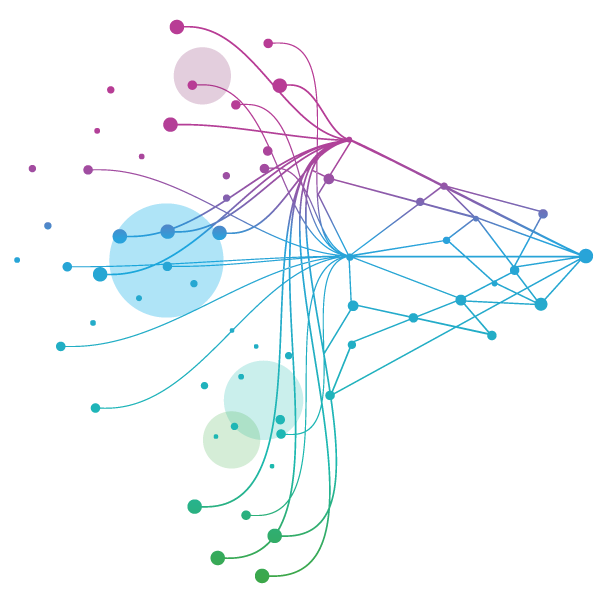Learn how IQVIA is unlocking genomic data, at scale, while preserving privacy. Enabling a faster, more flexible, and less expensive approach for scientific enquiry into human biology, drug discovery and drug development.
In the transformative landscape of healthcare, genomics stands at the forefront of innovation. According to the October 2024 report published by the Wellcome Trust in collaboration with IQVIA, there has been a significant proliferation of major genomics initiatives globally (IQVIA and Wellcome trust, 2024). This comprehensive study, which analyzed 198 genomics initiatives worldwide, provides quantitative evidence of the field's exponential growth and its potential for revolutionizing personalized medicine.
A national genomic initiative is typically a collective effort aimed at enhancing public health by establishing a framework for the use of genomic data and technology, with large-scale biobanks often included as a component of these initiatives. However, the foundation of such groundbreaking initiatives is contingent upon the efficacy and availability of funding. This blog aims to dissect the current funding characteristics for such large-scale genomic initiatives, providing a valuable resource for governments and entities within the EU that aspire to launch or support such critical projects. In addition, this analysis serves as a continuation of our work, zooming in on the unique opportunities within the EU's national genomic framework.
The trajectory of national genomic initiatives across the European Union is marked by a significant rise in both their quantity and magnitude. This growth is driven by increased EU funding for health and digital initiatives, with €10s of billions allocated through fiscal programs, thereby amplifying their impact. According to the European Commission, our analytical framework divides EU countries into two principal categories: beneficiaries of the EU Cohesion Fund, which have a Gross National Income (GNI) per capita beneath 90% of the EU's average, and the non-beneficiary counterparts.
Utilizing the status of EU countries as Cohesion Fund beneficiaries as a basis for categorizing genomic initiatives offers valuable insights, even though the fund itself does not specifically target genomic research. This classification serves as an economic proxy, indicative of the broader financial and infrastructural capabilities that underpin scientific progress within each nation. While the Cohesion Fund's primary focus is on achieving socio-economic balance, it provides a useful socio-economic differentiation that can be considered when examining the landscape of genomic initiatives across EU countries. Here, we present a detailed analysis of 63 initiatives, compiled from IQVIA's work and secondary research, highlighting the relationship between a nation's economic development and its ability to successfully drive genomic research from inception to fruition.

Source: IQVIA Genomics and Precision Medicine analysis; initiative official websites and press release
In the early 2000s, the genomic landscape was nascent, with only 8 initiatives across both groups. The decade that followed witnessed a surge, with a combined total of 32 initiatives, reflective of the growing recognition of genomics as a pivotal healthcare pillar as illustrated in Figure 1. At the onset of the 2020s, the pandemic momentarily slowed activities, yet despite this, the period from 2020 to the present (2024) has seen a sustained commitment, particularly from the Cohesion Fund Beneficiaries, with 9 initiatives in Cohesion Fund beneficiaries and 5 in non-beneficiaries. This unwavering support during challenging times suggests that the recognition of genomic research as a crucial pillar for advancement, paired with its resilient funding even in challenging times, underscores the strategic importance placed on this field.
Even though the average genomic initiative completion time (defined as the end of initial funding) for past initiatives is 3 years, the timeframe for completing genomic initiatives varies widely, reflecting the diverse nature and scope of the projects undertaken. While many of these initiatives are still in progress, the completed ones have ranged from a swift 2 years to a lengthy 20 years, depending on their objectives and complexity. The duration is influenced by the specific goals, such as establishing a national genomic reference center, creating a national biobank, or orchestrating multi-center, multidisciplinary projects that delve into new health technologies and personalized medicine. Moreover, numerous initiatives are continuously collecting data as they sequence new genomes and gather fresh tissue samples on an ongoing basis. This range in completion times underscores the tailored approach to each initiative, adapting to the unique challenges and opportunities they present, rather than suggesting a one-size-fits-all timeframe for genomic research progress.
The funding landscape for EU genomic initiatives reveals a symbiotic ecosystem wherein "Public co-funding supplemented to national government funding" emerges as the predominant model, encapsulating the collaborative spirit driving these projects forward (Figure 2). Governmental contributions are not merely financial inputs but act as foundational pillars that stimulate additional investments. Among the 60 initiatives assessed, the prevalence of joint funding in 28 cases highlights a strategic preference for pooling resources across sectors. National government funding singularly supports 20 initiatives, while EU funds and private investments contribute to 9 and 4 initiatives, respectively, underscoring the varied yet interconnected sources powering genomic research.
Within the joint funding paradigm, national government investment is omnipresent, playing a crucial role in attracting and securing supplementary funding. This layered co-funding structure includes 48% of initiatives supplemented by EU funds, 22% by private and for-profit contributions, and 11% by research funding. Moreover, intricate collaborations that combine EU funding with research grants (7%), as well as triple alliances of EU funding, research grants, and private sector investments (4%), exemplify the multifaceted approach needed to meet the demands of genomic innovation. By serving as both a bedrock and a beacon for further funding, government investment not only fuels scientific advancement but also leverages the collective strength of various stakeholders, propelling genomic initiatives to their full potential.

Source: IQVIA Genomics and Precision Medicine analysis; initiative official websites and press release
Over the past decade, the execution landscape of genomic initiatives within the EU has undergone a significant evolution, increasingly favoring collaborative efforts over solitary endeavors. As shown in Figure 2, between 2010 and 2020, research organizations took the lead on 8 initiatives in EU Cohesion Fund Beneficiary countries and 5 in non-beneficiary countries, laying the groundwork for a community-centric approach to genomic research. Furthermore, research consortiums, which foster a more collective research environment, led 1 initiative among Cohesion Fund beneficiaries and 6 among non-beneficiaries, signaling the beginning of a shift towards greater cooperation. Notably, 4 initiatives during this period were led exclusively by governmental institutes in non-beneficiary countries, highlighting the varied approaches to genomic research across the EU.
The trend towards increased collaboration has only strengthened from 2020 to the present. Between 2010 and 2020, the execution of genomic initiatives primarily adopted a research organization format with 13 instances. In contrast, the research consortium format was less prevalent, with only 7 occurrences—and notably, 6 of these consortia were driven by countries outside the EU Cohesion Fund beneficiaries (Figure 3). Fast forward to the period from 2020 to 2024, and the landscape begins to shift. In recent years, 3 initiatives led by research organizations have been observed in the EU, alongside 4 led by research consortiums. Of these consortium-led initiatives, 2 are from EU Cohesion Fund beneficiary countries and 2 from non-beneficiary countries. This period marks a clear move toward greater collaboration, with research consortiums gaining ground and demonstrating an increased presence in both types of EU nations. This balance underscores a broader, EU-wide commitment to collaborative research irrespective of economic status. Moreover, the rise of international collaborations, exemplified by 3 initiatives including the ambitious “1+ Million Genomes” initiative, the Genomic Data Infrastructure (GDI) project, and the EURO-NMD Registry, represents a significant stride toward a unified genomic research framework. These partnerships, particularly within Cohesion Fund Beneficiary countries, have not only increased in frequency but have also enhanced the capacity for innovation, showcasing the power of collaborative synergy in driving genomic initiatives to new heights.

Source: IQVIA Genomics and Precision Medicine analysis; initiative official websites and press release
Our analysis also highlights the financial commitment to genomics. Despite limited public data, the average funding amount per initiative has risen sharply from 94 million EUR between 2010-2020 to 178 million EUR from 2020 to 2024. The annual average funding also saw an increase, from 26 million EUR to 72 million EUR in the respective periods, highlighting the increasing investments and confidence in the transformative potential of genomics (Figure 4). This rise in average funding per genomic initiative can be attributed to technological advancements, expanded research objectives, increased recognition of genomics' value in healthcare, and the trend towards larger, more collaborative initiatives involving multiple institutions and countries.
EU stakeholders looking to fund genomic initiatives have two primary sources to consider and fuel the future genomic and biobanking initiatives: Horizon Europe and the EU4Health Program. With a substantial 95.5 billion EUR budget for 2021-2027, Horizon Europe is the EU's principal research and innovation program, encompassing a range of activities including genomics, and inviting proposals through initiatives like "1+ Million Genomes." Concurrently, the EU4Health Program, backed by a 4.4 billion EUR budget, focuses on strengthening healthcare systems and supporting genomic infrastructure. In addition to the two main sources, the EU's fiscal funds also indirectly finance genomic initiatives through allocations to member states . Interested parties are encouraged to stay updated on open calls and carefully follow the application processes outlined on their respective portals.

The annual average funding amount is derived by dividing the total funding for a completed genomic initiative by the project's duration
Source: IQVIA Genomics and Precision Medicine analysis; initiative official websites and press release
The funding landscape for EU genomic and precision medicine initiatives is complex yet ripe with opportunity. With the increasing importance of genomics in healthcare, understanding the intricacies of funding sources, collaborative frameworks, and execution strategies is crucial for stakeholders looking to embark on new projects. However, future challenges must also be addressed to ensure the long-term success and impact of these initiatives.
Key areas that require attention and funding include:
- Enhancing diversity in genomic data collection, as highlighted by the recent Wellcome Trust/IQVIA report (Data and diversity in genomics: landscaping report, Oct 2024), to ensure representation across different populations.
- Improving interoperability and linkage across genomic databases to facilitate more comprehensive research and analysis.
- Expanding beyond genomics to integrate proteomics and other "omic" data for a more holistic understanding of human biology.
- Translating genomic insights into tangible healthcare benefits and demonstrating return on investment in clinical settings.
- Addressing data management and storage challenges associated with the increasing volume of genomic information.
- Maintaining global competitiveness in genomic research and innovation.
As we look to the future, the ongoing evolution and increased funding for genomics are vital for unlocking the promise of personalized medicine. It is imperative for governments, research institutions, and stakeholders across the EU to harness these insights and create partnerships that will propel healthcare innovation forward. IQVIA is ready to support this evolving landscape, fostering conversation, collaboration, and strategic planning. Our goal is to help coordinate efforts at a national level in a way that benefits patients and contributes to innovative advances in healthcare.
In the spirit of progressive collaboration, we invite readers to explore the funding pathways detailed in this analysis and to reach out for further engagement. Together, we can catalyze the genomic revolution and usher in a new era of healthcare that is precise, personalized, and profoundly impactful for patients.


References:
- Wellcome Trust Landscaping report: Data and diversity in genomics.
- IQVIA Thought Leadership White Paper - Understanding the Global Landscape of Genomic Initiatives: https://www.iqvia.com/insights/the-iqvia-institute/reports-and-publications/reports/understanding-the-global-landscape-of-genomic-initiatives
- European Commission website: https://commission.europa.eu/funding-tenders/find-funding/eu-funding-programmes/cohesion-fund-cf_en
- IQVIA blog - The EU’s forgotten billions: https://www.iqvia.com/blogs/2024/05/the-eus-forgotten-billions


























